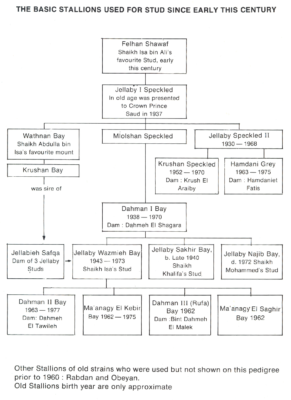Bahraini breeding practices
Volume 1 of the Bahrani stud book published in 1980 describes the breeding practice of the Al Khalifa family at the time.
“No outside stallion is directly used for stud purposes. New blood is introduced indirectly by the high-caste mares received or exchanged with other Sheikhs from the interior of Arabia. When these mares are bred to local stallions, their progeny or grand-progeny will sometimes qualify as studs.
The different strains or families of Arab horses are perpetuated through the mares, offspring always taking the dam’s name regardless of the stallion’s strain. Although all the strains found in Bahrain are equally pure, stud horses are chosen only from the strains deemed most noble. The word ‘noble’ here is the nearest equivalent to the Arab word ‘asil’ and does not convey the exact meaning. All tribes recognize the inherent mobility of certain strains but the preference for some strains over others varied from tribe to tribe.
It was the custom in Central Arabia for the prominent Sheikhs to keep stud horses from a few selected strains only, but in some tribes after repeated breeding of these stallions with mares of a ‘new’ strain, the progeny of the letter gradually gained acceptance as studs. In general, once a stallion has been chosen to stand as stud, his strain becomes unimportant. The fact that he is chosen is the guarantee of his nobility.
In Bahrain a new generation’s tribal Sheikh would often favor a different strain to his predecessor and would increase horses of his favorite family line. However, the ancient revered lines maintained their supremacy in the long run, although unfortunately one or two of them have disappeared.” (pg6).
Prior to 1980, Volume 1 identifies the horses below which were used as breeding stallions. (pg10).

Thank you for this – a very interesting read!
Yes, I enjoyed reading this while drinking my morning coffee, thank you for the share. It is interesting to see the usage of ‘noble’ in this context; not the first time I have seen it.